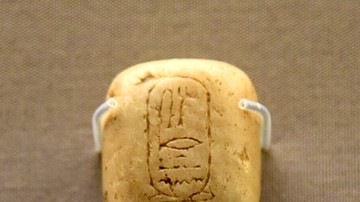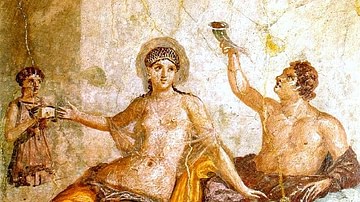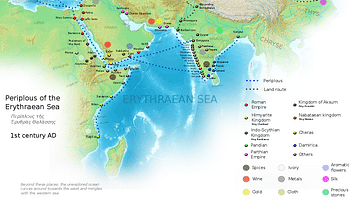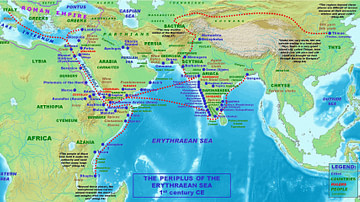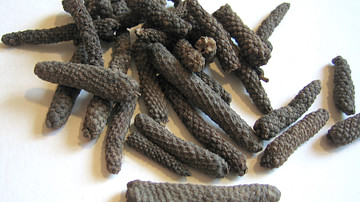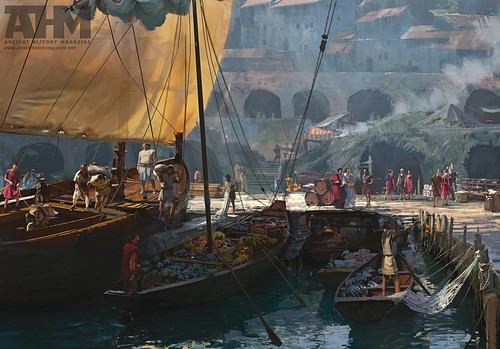
The Periplus of the Erythraean Sea is an eyewitness account of ancient travel to Africa and India via the Red Sea written by an unknown Greek-speaking Egyptian author in the 1st century CE. In this detailed account, the conditions of the routes are described, along with the ports along the way, the demeanor of the locals, and the major imports and exports.
The Periplus of the Erythraean Sea (Latin: Periplus Maris Erythraei) is an astonishing record of trade in the ancient world. As described by Schoff:
The Periplus of the Erythraan Sea is one of those human documents, like the journals of Marco Polo and Columbus and Vespucci, which express not only individual enterprise, but the awakening of a whole race toward new fields of geographical discovery and commercial achievement. It is the first record of organized trading with the nations of the East, in vessels built and commanded by subjects of the Western World. It marks the turning of a tide of commerce which had set in one direction, without interruption, from the dawn of history. (3)
Authorship & Dating
Known from a single manuscript now in Heidelberg and held from the early 10th century and a much later copy in the British Museum, the Periplus of the Erythraean Sea was written in a mixture of classical and common Greek sometime between 40-55 CE. The Erythraean Sea was the ancient name for the body of water located between the Horn of Africa and the Arabian Peninsula, and the Periplus was likely a merchant's diary, containing the first information about the inhabitants of the coast of East Africa, more than half a millennium before any other comparable written mentions.
The date it was written can only be surmised by its references to places and events. The author mentions the discovery of the route to India by Hippalus, which historians believed occurred about 47 CE. Nearly all authorities believe that the Periplus is earlier than Pliny’s Natural History, which is known to have been published between 73 and 77 CE. Arguments have even been made that Pliny may have borrowed from the Periplus, although these suggestions are by no means conclusive. Schoff (1912) and others have placed the most likely date for the Periplus of 60 CE.
From the account, it is clear the author personally made the voyage to India. He lived in Berenice on the Red Sea rather than Alexandria, since he offers no account of the journey up the Nile and across the desert from Coptos, which Strabo and Pliny describe at length. It is thought that he was not a highly educated man, as "evident from his frequent confusion of Greek and Latin words and his clumsy and sometimes ungrammatical constructions." The great value of his work is not literary, "but in its trustworthy account of the trade of the Indian Ocean and of the settlements around its shores; concerning which, until his time, we possess almost nothing of an intelligent and comprehensive nature" (Scoff, 16).
The Eastern Trade Network of Ancient Rome
The amount of Roman trade passing through Red Sea ports was upped dramatically when Roman Emperor Augustus (r. 27 BCE - 14 CE) brought Egypt under Roman control in 30 BCE. The Greek geographer, philosopher, and historian Strabo reported that "in his day 120 vessels sailed regularly from Egypt to India, whereas previously very few made the journey" (Geography, 16.4).

Two major trade routes emerged under the Roman Empire that spanned about 4800 kilometers (3000 mi). There was a southern route that went down the Red Sea and then along the eastern coast of Africa to Rhapta, close to present-day Dar es Salaam, and another that also went down the Red Sea but then went east across the Indian Ocean to ports in India. The full journey down the coast of Africa from Egypt took about two years to complete, while that to India and back was closer to a year.
Ships carrying goods bound for both Africa and India left the Red Sea ports between July and September and were steered south down the middle of the Red Sea to avoid the dangerous coastlines. The ships bound for African ports then headed to Cape Guardafui on the Horn of Africa and then south to Rapta, hugging the African coast. The ships bound for India, sailed to the ports of Aden and Qana’ on the southern coast of Arabia, and then grabbed the monsoon winds across the open waters of the Indian Ocean to southwest India.
The Route Described in the Periplus of the Erythraean Sea
The Periplus describes the trip along the coast of Arabia:
Directly below this place is the adjoining country of Arabia, in its length bordering a great distance on the Erythraean Sea. Different tribes inhabit the country, differing in their speech, some partially, and some altogether. The land next the sea is similarly dotted here and there with caves of the Fish-Eaters, but the country inland is peopled by rascally men speaking two languages, who live in villages and nomadic camps, by whom those sailing off the middle course are plundered, and those surviving shipwrecks are taken for slaves… Navigation is dangerous along this whole coast of Arabia, which is without harbors, with bad anchorages, foul, inaccessible because of breakers and rocks, and terrible in every way. Therefore, we hold our course down the middle of the gulf and pass on as fast as possible by the country of Arabia until we come to the Burnt Island; directly below which there are regions of peaceful people, nomadic, pasturers of cattle, sheep and camels.
(Periplus of the Erythraean Sea, 20).
The first port they visited in India was Barbaricum. The Periplus describes:
The ships lie at anchor at Barbaricum, but all their cargoes are carried up to the metropolis by the river, to the King. There are imported into this market a great deal of thin clothing, and a little spurious; figured linens, topaz, coral, storax, frankincense, vessels of glass, silver and gold plate, and a little wine. On the other hand, there are exported costus, bdellium [resin of myrrh], lyceum [a Solanaceous herb], nard, turquoise, lapis lazuli, Seric skins, cotton cloth, silk yarn, and indigo. And sailors set out thither with the Indian Etesian winds, about the month of July, that is Epiphi: it is more dangerous then, hut through these winds the voyage is more direct, and sooner completed.
(Periplus of the Erythraean Sea, 39).
Once in India, the Romans visited ports along the coast from Barbaricum, on the Indus River, Muziris (Cranganur) on the southwestern Malabar Coast, and then Sri Lanka. Important trading partners were the Tamil dynasties of the Pandyas, Cholas, and Cheras in southern India. The first major spice trade center in the world became Muziris, located in the Indian State of Kerala on the southwestern coast of India. The exact location is not known. Probably established by 3000 BCE, it remained one of India’s most important trading ports through the Roman period. In the Akananuru, a collection of ancient Tamil poetry, it was described as "the city where the beautiful vessels, the masterpieces of the Yavanas [westerners], stir white foam on the Periyar, river of Kerala, arriving with gold and departing with pepper" (Perur, 2016). Black pepper was the major export of this great emporium, constituting three-quarters of the bulk of the west-born cargo, but other Indian trade items included locally gathered ivory and pearls, and semi-precious stones and silks from the Gangetic Valley and East Himalayan regions.
At each stop along the way, different local commodities were offered for trade, sometimes for gold coins and other times for barter, including goods like cloth, silver and gold statues, cereals, wine, and olive oil. Frankincense and myrrh from South Arabia were extremely popular in India, along with gold and silver, for which the Indians traded their locally produced pepper, cotton, and pearls, along with silks they had obtained from Chinese traders. On the trip down the African coast, Egyptian linen, glass, wine, and metal products would be traded for African ivory, tortoiseshell, myrrh, and frankincense, along with cinnamon, Indian cloth, sashes, and fine muslins obtained from their trade with Indian merchants.
From India, they headed home, rarely traveling any deeper into Southeast Asia. Once their ships were filled, the traders would head back to the Egyptian ports of Myos Hormos and Berenike. There, consignments of their treasures were sent overland on camel caravans, and then shipped to the commercial hub of Roman Egypt, the city of Alexandria. The diversity of the goods sent across the desert would have been simply breathtaking: Arabian frankincense, Sri Lankan and Chinese cinnamon, Indian pepper, pearls and precious stones, Chinese silks and porcelain, African myrrh, ivory, rhinoceros horn, and tortoiseshell.




